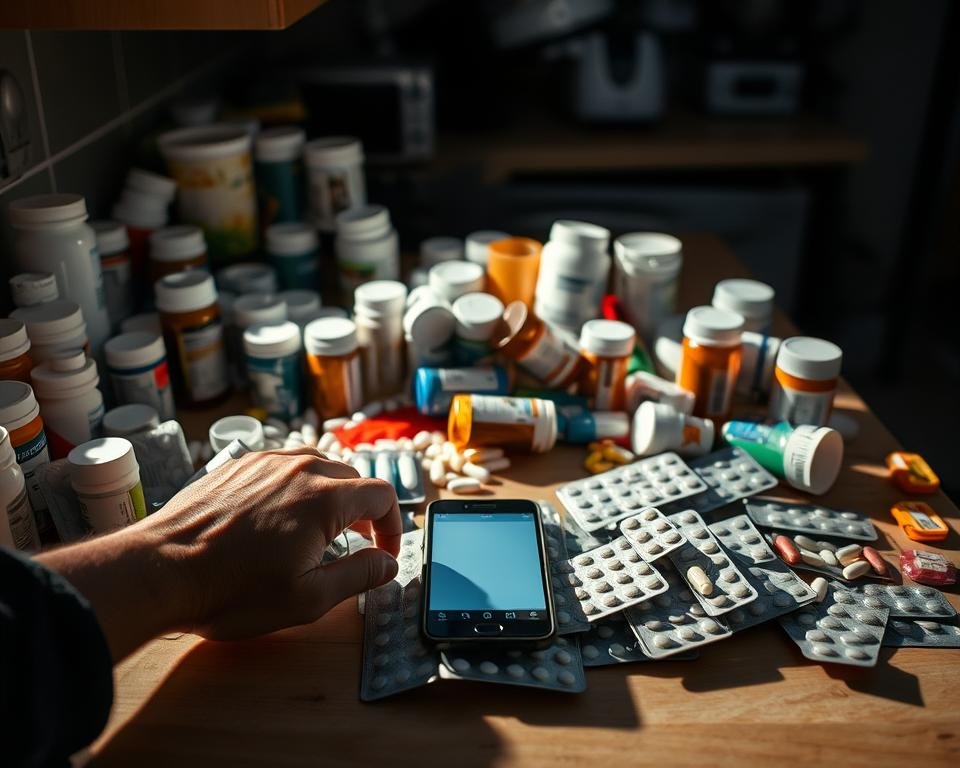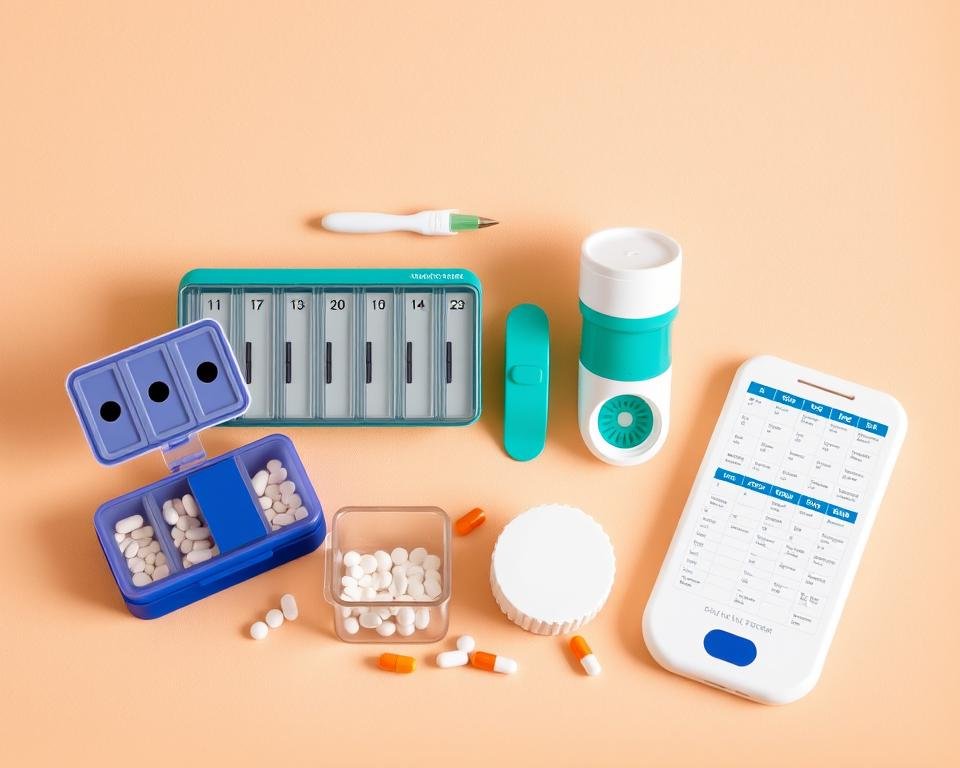“The art of medicine consists of amusing the patient while nature cures the disease.” – Voltaire’s words remind us that smart care strategies matter. When you’re juggling different treatments, organization isn’t just helpful – it’s vital for your well-being.
Did you know 1 in 5 Americans over 40 uses five or more prescription drugs? Jessica Merrey, Pharm.D. at Johns Hopkins, explains: “Clear systems prevent errors and help your body heal.” Whether it’s vitamins, heart pills, or insulin, tracking doses and refills keeps your health on track.
This guide shows simple ways to stay safe. You’ll learn to create routines that fit your life, use tools like pill organizers, and communicate better with your pharmacist. Small steps – like setting phone reminders or keeping an updated list – make big differences.
Key Takeaways
- Over 20% of U.S. adults aged 40+ take five or more prescribed drugs
- Organized routines reduce errors and improve treatment results
- Pharmacists recommend tracking tools like dose schedules and refill alerts
- Simple habits (e.g., weekly pill organizers) save time and stress
- Regular check-ins with your doctor ensure safer medication use
Understanding the Importance of Managing Multiple Medications
Juggling different pills each day? You’re not alone—over 30% of adults aged 65+ take five or more prescriptions. “Polypharmacy becomes riskier as we age,” notes Ghada Ashkar, PharmD at UCLA Health. Your body processes drugs differently after 50, making careful coordination essential.

Why Polypharmacy Gets Tricky
The CDC reports that 35% of hospital admissions for seniors stem from medication issues. Taking several treatments daily raises two main risks:
- Unexpected side effects like dizziness or confusion
- Dangerous drug interactions that reduce effectiveness
Even timing matters—taking blood pressure pills at the wrong hour might weaken their impact. Ashkar warns: “A one-hour mistake sometimes changes outcomes.”
How Aging Changes the Game
Chronic conditions like diabetes or arthritis often require more prescriptions. But kidneys and liver work slower with age, letting drugs linger longer. This means:
- Higher chance of effects becoming severe
- Increased need for precise schedules
Make sure to share updated lists of all pills and supplements with your doctor. When traveling with prescriptions, double-check time zones against dose times.
Set phone reminders for each dose and ask your physician for quarterly medication reviews. Small precautions today prevent big problems tomorrow.
Setting Up Your Medication Schedule and Routine
Ever felt overwhelmed by your daily pill routine? You’re not alone. Building a reliable system helps you stay consistent and confident. Let’s break it down into simple steps that work with your unique rhythm.

How to Follow Schedules and Doses
Start by writing down exact times for each dose. Use your phone’s alarm app or a kitchen timer for reminders. If you take one pill in the morning and two at night, set separate alerts. Pro tip: Name alarms like “Blood Sugar Meds” instead of generic labels.
Always confirm instructions with your pharmacist. For example, some drugs work best with food, while others need an empty stomach. Stick to the same mealtimes when possible – consistency boosts effectiveness.
Creating a Personal Calendar or Chart
Grab a weekly planner or print a free template online. List each drug, its dose, and timing. Color-code entries for quick scanning – blue for morning pills, red for evening ones. Update it when your provider adjusts your regimen.
Try apps like Medisafe or Round Health. They track refills and send alerts if you miss a dose. Prefer paper? Keep your chart near coffee supplies or the bathroom mirror – spots you visit daily.
- Check pill bottles every Sunday to spot low supplies
- Schedule refill requests 3 days before you run out
- Share your chart during doctor visits for accuracy checks
Using a Pill Organizer and Other Tools
Staying on top of your health routine doesn’t have to feel like solving a puzzle every day. Simple tools can turn chaos into clarity, helping you maintain control without stress. Let’s explore practical solutions that fit your lifestyle.

Benefits of a Pill Organizer
A weekly pill organizer acts like a personal assistant for your health. With compartments labeled for days or specific times, you’ll see at a glance whether you’ve taken your midday dose. No more guessing games with pill bottles! Choose one with color-coded sections if you take supplements alongside prescriptions.
Many find it helpful to fill their organizer every Sunday while brewing coffee or watching TV. This habit takes five minutes but prevents missed doses all week. For extra safety, place it near your food storage area if certain pills require meals.
Leveraging Technology: Apps and Alarms
Smartphone apps like Medisafe send friendly nudges when it’s time to take your pills. They also track refills and warn about interactions with supplements. Prefer something simpler? Set recurring alarms named after each medication (“Thyroid Pill – 8 AM”).
Some apps even generate shareable reports for doctors. Pair these tools with a physical counter (like a magnetic pill strip) to double-check doses. Remember to organize your pills in a quiet, well-lit space to avoid mix-ups.
Medication Management Multiple Prescriptions: Best Practices
Your healthcare team is your greatest ally in staying safe. Open conversations with professionals help catch potential issues early. “Bring every pill bottle to appointments,” advises Dr. Lisa Nguyen, a clinical pharmacist. “Even over-the-counter products matter.”
Build Trust with Your Care Team
Use one pharmacy for all prescriptions. This lets your pharmacist spot risky interactions between drugs or supplements. Share updates if you start new vitamins or herbal remedies. Experts at Johns Hopkins Medicine recommend keeping a current list in your wallet.
Ask questions like:
- “Could this affect my other pills?”
- “Should I take this with food at night?”
Spot Problems Before They Escalate
Track how you feel after starting a new treatment. Drowsiness or rashes might signal a bad drug interaction. Use a notebook or app to log symptoms and share them quickly with your provider.
Set monthly reminders to:
- Review refills and expiration dates
- Confirm dosage changes with your pharmacist
- Dispose of unused pills safely
Small checks today keep your routine smooth tomorrow.
Conclusion
Keeping your health journey smooth starts with a solid plan for your daily treatments. By organizing your medicine schedule and tracking prescriptions, you reduce risks like unexpected side effects or harmful drug interactions. Remember – even one skipped day or incorrect dose can throw off your progress.
Always share updates with your physician if you notice unusual reactions. Stick to consistent time slots, especially for evening doses when fatigue might lead to mistakes. Your pharmacist can help spot issues if you use one pharmacy for all refills.
Store drugs properly in dry areas and dispose of expired pills safely. Review your system monthly – update lists, check supplies, and confirm instructions. With simple habits and open communication, you’ll handle your medications confidently.
You’ve got this! Small tweaks to your routine make big differences in how you feel every day. Keep learning, stay organized, and trust your care team to guide you.
